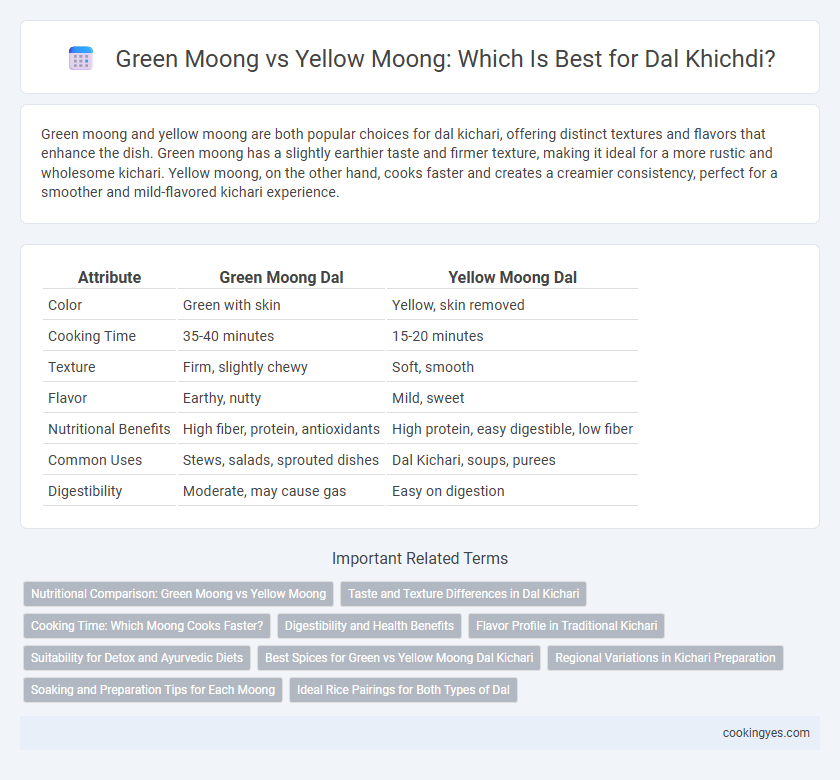Green moong and yellow moong are both popular choices for dal kichari, offering distinct textures and flavors that enhance the dish. Green moong has a slightly earthier taste and firmer texture, making it ideal for a more rustic and wholesome kichari. Yellow moong, on the other hand, cooks faster and creates a creamier consistency, perfect for a smoother and mild-flavored kichari experience.
Table of Comparison
| Attribute | Green Moong Dal | Yellow Moong Dal |
|---|---|---|
| Color | Green with skin | Yellow, skin removed |
| Cooking Time | 35-40 minutes | 15-20 minutes |
| Texture | Firm, slightly chewy | Soft, smooth |
| Flavor | Earthy, nutty | Mild, sweet |
| Nutritional Benefits | High fiber, protein, antioxidants | High protein, easy digestible, low fiber |
| Common Uses | Stews, salads, sprouted dishes | Dal Kichari, soups, purees |
| Digestibility | Moderate, may cause gas | Easy on digestion |
Nutritional Comparison: Green Moong vs Yellow Moong
Green moong dal contains higher protein content and more dietary fiber compared to yellow moong dal, supporting better digestion and sustained energy release. Yellow moong dal is richer in carbohydrates and has a slightly lower glycemic index, making it suitable for steady blood sugar control. Both varieties provide essential vitamins like folate and minerals such as potassium, but green moong offers a marginally better antioxidant profile.
Taste and Texture Differences in Dal Kichari
Green Moong dal offers a nuttier, earthier flavor with a slightly firmer texture, making it ideal for a rustic, wholesome Dal Kichari. Yellow Moong dal cooks faster, yielding a creamier and smoother consistency that blends seamlessly into the dish. Choosing between them depends on the preferred balance of taste intensity and textural softness in Dal Kichari.
Cooking Time: Which Moong Cooks Faster?
Green moong beans require a longer cooking time compared to yellow moong dal due to their intact outer husk, which makes them denser and tougher. Yellow moong dal, being split and dehusked, cooks significantly faster, often softening within 15-20 minutes, ideal for quick dal kichari preparation. Choosing yellow moong dal reduces overall cooking time, making it a preferred option for time-efficient and easily digestible kichari dishes.
Digestibility and Health Benefits
Green Moong dal is richer in fiber and antioxidants, enhancing digestive health by promoting gut motility and reducing inflammation. Yellow Moong dal is easier to digest due to its lower fiber content and reduced anti-nutrients, making it ideal for sensitive stomachs. Both varieties support protein intake and provide essential vitamins, but Green Moong is often preferred for detoxification while Yellow Moong is favored for quick energy and smoother digestion in dal kichari.
Flavor Profile in Traditional Kichari
Green Moong offers a robust, earthy flavor with a slightly bitter undertone, enhancing the traditional Dal Kichari's depth and complexity. Yellow Moong provides a milder, sweeter taste that results in a smoother and more delicate kichari texture. The choice between Green Moong and Yellow Moong directly influences the dish's aromatic intensity and mouthfeel in classic Indian cuisine.
Suitability for Detox and Ayurvedic Diets
Green moong dal contains higher fiber and antioxidant levels compared to yellow moong, making it more effective for detoxification and cleansing diets. Yellow moong dal is easier to digest and has a mildly sweet taste, aligning well with Ayurvedic principles for balancing digestive fire (Agni) and promoting gentle detox. Both dals provide essential nutrients, but green moong's potent detox properties suit intensive cleansing regimens, while yellow moong supports daily Ayurvedic diet routines.
Best Spices for Green vs Yellow Moong Dal Kichari
Green moong dal kichari pairs best with spices like cumin seeds, ginger, and green chilies that enhance its earthy flavor and aid digestion. Yellow moong dal kichari complements warming spices such as turmeric, coriander powder, and asafoetida, which bring out its mild, slightly sweet taste while boosting nutritional benefits. Both dals benefit from bay leaves and black pepper to add depth and subtle heat to the dish.
Regional Variations in Kichari Preparation
Green moong dal, popular in North India, is often preferred for kichari due to its earthy flavor and slightly firmer texture, which holds well during slow cooking. In contrast, yellow moong dal, favored in South India, offers a softer, sweeter taste and quicker cooking time, ideal for the region's spiced and soupy kichari variants. Regional preferences influence spice blends and ingredient pairings, with northern kichari incorporating cumin and ginger, while southern versions emphasize curry leaves and mustard seeds.
Soaking and Preparation Tips for Each Moong
Green moong dal requires longer soaking, typically 6 to 8 hours, to soften its tougher seed coat, whereas yellow moong dal benefits from a shorter soak of 2 to 4 hours due to its split and husked form. For green moong, rinsing multiple times before soaking helps reduce bitterness and shorten cooking time, while yellow moong dal can be rinsed lightly without compromising texture. Pressure cooking times differ, with green moong taking about 15 to 20 minutes and yellow moong needing only 8 to 10 minutes, optimizing both texture and nutrient retention for dal kichari.
Ideal Rice Pairings for Both Types of Dal
Green Moong dal offers a robust, earthy flavor that pairs exceptionally well with fragrant Basmati rice, enhancing the wholesome texture of dal kichari. Yellow Moong dal, with its mild, slightly sweet taste, complements well with plain or lightly spiced Jeera rice, creating a balanced and comforting meal. Opting for aromatic rice varieties tailored to each dal type elevates the overall sensory experience and nutritional harmony of the dish.
Green Moong vs Yellow Moong for Dal Kichari Infographic

 cookingyes.com
cookingyes.com